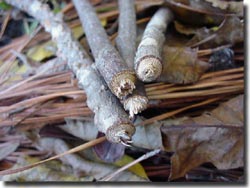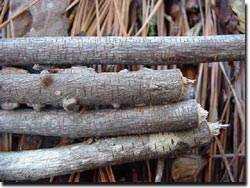If you have noticed small branches on the ground in the fall neatly cut from your hickory, pecan, oak, and elm, among other trees, you have NOT been invaded by an alien. An insect known as a twig girdler has visited your tree. This insect is commonly called a longhorned beetle in its adult stage and each fall, usually September through November, these beetles neatly girdle tree branches about the diameter of a pencil. The branches will fall to the ground and by the time the homeowner finds them, the beetle that girdled the branch has left. Because of this, the adult beetle is seldom seen. Damage from twig girdlers is more common some years than others.
The adult beetle is about 1/2 to 3/4 inch long, has antennae about as long as its body, and is grayish brown with a broad ash gray band across the middle of its back. The adult beetles emerge in the late summer and fall and locate a host tree. Here they chew around and around the branch forming a V-shaped notch. They usually don’t completely sever the branch, but leave a small section connected in the center. The chewing looks somewhat like a miniature beaver has gnawed on the branch. The partially severed branch usually breaks from the tree and either falls to the ground, lodges in the tree crown, or hangs loosely attached where it was girdled. Close examination of the severed branches reveals tiny scratches where the beetle has chewed the bark. The female beetle lays about ten eggs on each severed branch and may deposit a total of 200 eggs. The eggs hatch in about three weeks and the larvae feed in the cut branch. In late summer, the larvae pupate and about two weeks later emerge as adults. There is one generation per year and adults generally live six to ten weeks. For those who are interested, the twig girdler is in the insect order Coleoptera (beetles), the family Cerambycidae (longhorned beetles) and the species is Oncideres cingulata.
These insects seldom do any serious harm to trees and are mostly a nuisance. They have been known to cause significant damage in pecan orchards and nurseries. Spraying with a chemical insecticide is not recommended for controlling twig girdlers in a yard situation. Instead, collect and destroy clipped branches.
If you find small branches on the ground under your trees that have been very cleanly and uniformly cut, you should now recognize that a twig girdler has been busy in your tree. Don’t be alarmed; the damage is rarely of any consequence.
The following photographs show typical signs of twig girdler activity. The first picture clearly depicts the precise cuts the adult beetles have made on pencil-sized twigs. Notice that a thin section in the middle of the twig was not cut but the twig has broken off.

The next picture shows a twig that has been partially cut by an adult twig girdler and the twig has not yet been broken.
.jpg)
The last picture shows where adult beetles have made scratch marks with their mandibles on the severed end of the branch.
